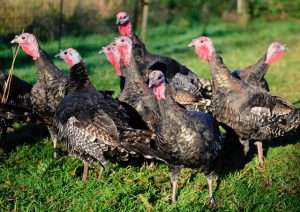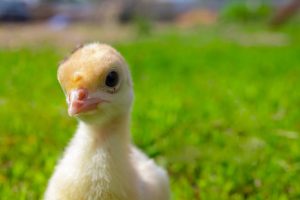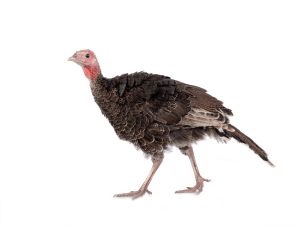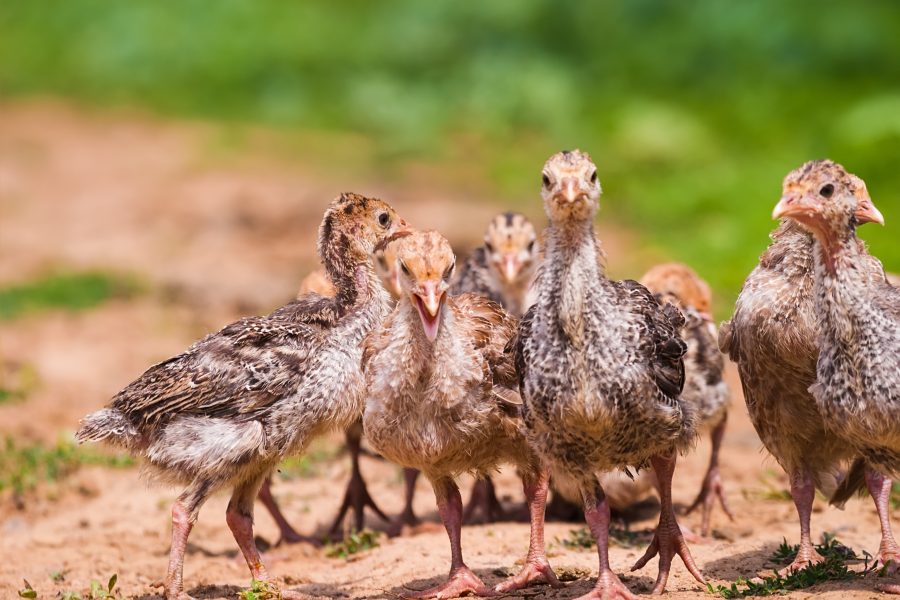The Country Smallholder reveals its top tips for rearing turkey poults…
Poults from an incubator can go directly into the shed in which they will be reared, as long as electricity is available. From day-old to about six weeks they will need some form of heating, especially at night. A cosy broody is useful but the poults will grow too big for this in only a couple of weeks. A suspended heat lamp will provide heat for as long as necessary, but its height will depend on the age of the poults and how they react. If the lamp is too high the poults will stand huddled up underneath because they are not sufficiently warm. Too low and they will lie in a circle away from the main heat. Therefore, adjust the height accordingly.
 For the first week or two, keep the poults in a relatively confined area so they can’t wander too far from the heat or feed. Make sure all the poults are feeding and drinking. If they are with a broody turkey, she will be encouraging the poults to eat but even then dip each day-old’s beak in a narrow-lipped drinker filled with fresh water and when it lifts its head it will swallow.
For the first week or two, keep the poults in a relatively confined area so they can’t wander too far from the heat or feed. Make sure all the poults are feeding and drinking. If they are with a broody turkey, she will be encouraging the poults to eat but even then dip each day-old’s beak in a narrow-lipped drinker filled with fresh water and when it lifts its head it will swallow.
From then on it will go to the drinker when thirsty. It is essential that poults have sufficient clean water always available and learn to drink quickly because they can soon suffer gut problems if they are starved of water.
To encourage eating, chop up a hard-boiled egg and mix this in with the turkey starter crumbs. Poults will usually copy each other, so as long as some are eating, others will follow. Gently dip a poult’s beak into the crumb mixture if it needs encouraging. Turkey poults need a specialist feed, and you can choose whether to use one with an added coccidiostat.
Occasionally you find a poult at about three to four days old that falls over onto its back and it will perish if not attended to. Young turkeys grow very quickly, and this may be something to do with nutritional intake. If you isolate the poult, putting it cushioned in a warm piece of fleece in a box and see that it feeds and drinks often, it will be able to return to the other poults in a couple of days. It may need to be fed by hand to make sure of the intake, but it is remarkable how they can gain strength this way.
If a poult gets a dirty vent or ‘sticky bum’ as it is often referred to, the dry faeces should be removed as gently as possible. Pick away small portions of the dirt whilst at the same time supporting the rear of the body. Never just tug away as a lot of damage can be done, especially if any faeces are attached to the inside of the vent.

As the poults grow, extend the area they can use. Even tiny poults are very inquisitive and adventurous so do not have anything high that they can jump onto at too early an age. Getting up is not the problem but coming down is and poults have been known to break the neck on landing. Once five or six weeks old they could be allowed a small straw bale to play about on and they would spend a lot of time doing this. Do not let poults perch on a pole until at least three months because of the soft-boned keel, which can become dented.
One question often asked is how do you tell the sexes apart? A skilled person can sex vent turkey poults at day-old but no-one should do this without training because damage can be done to the bird. A male though can have his wing feathers standing out, a little like an ostrich, at only a few days old. The sexes can begin to be identified by around seven weeks onwards by assessing the physical differences in the poults – that is if you have both sexes. A male has a slightly large and longer head, longer back, thicker hocks and larger legs and feet than a female. A male will develop more fleshy caruncles on the hairs down the back of the head and only a few small caruncles on the neck.
Poults can come off heat once they have their first set of proper feathers. This is usually around seven weeks – however, if the weather is chilly even feathered poults enjoy some heat especially overnight. If they are cold, there is a chance that they will huddle together to keep warm with the risk of being trampled or suffocated. Between five to seven weeks the poults should be moved onto growers pellets. It is a good idea to mix the growers with the starter crumbs for a week or two to get them used to the change. Do not feed any wheat until at least twelve weeks old.
 It fed correctly and the housing is kept clean, turkeys should remain fit. Some of the biggest health challenges to turkeys are via the gut so the aim is to keep this part of the bird as free from bacteria and parasites as possible. The pH level of a turkey’s gut is 4, ideal for many of the bugs that will try to invade it. By altering this level and making the gut slightly more acidic it becomes a less hospitable environment. Putting a little cider vinegar into fresh drinking water each day has shown some benefits but do not use metal drinkers for this purpose.
It fed correctly and the housing is kept clean, turkeys should remain fit. Some of the biggest health challenges to turkeys are via the gut so the aim is to keep this part of the bird as free from bacteria and parasites as possible. The pH level of a turkey’s gut is 4, ideal for many of the bugs that will try to invade it. By altering this level and making the gut slightly more acidic it becomes a less hospitable environment. Putting a little cider vinegar into fresh drinking water each day has shown some benefits but do not use metal drinkers for this purpose.
Turkeys should be wormed at around 7, 10 and 16 weeks of age and when undertaking this, housing should be thoroughly cleaned out and all litter removed because there will be immediate re-infestation if litter or faecal material is contaminated with worm eggs. The worming treatments licensed for poultry in the UK are 60g pots of Flubenvet by Elanco and Flubendazole by Kernfarm.
If raising turkeys for Christmas remember that the standard pure breed varieties need longer to mature than the commercial. Ideally, all poults should be off heat by late June/early July to be mature for early December, as turkeys require to be hung for 10 days before evisceration. When rearing or buying in poults for meat, arrange how they are to be slaughtered. By law only trained, skilled people may slaughter any species of poultry.
To receive regular copies of The Country Smallholder magazine featuring more articles like this, subscribe here.
For FREE updates from the world of smallholding, sign up for The Country Smallholder newsletter here.








